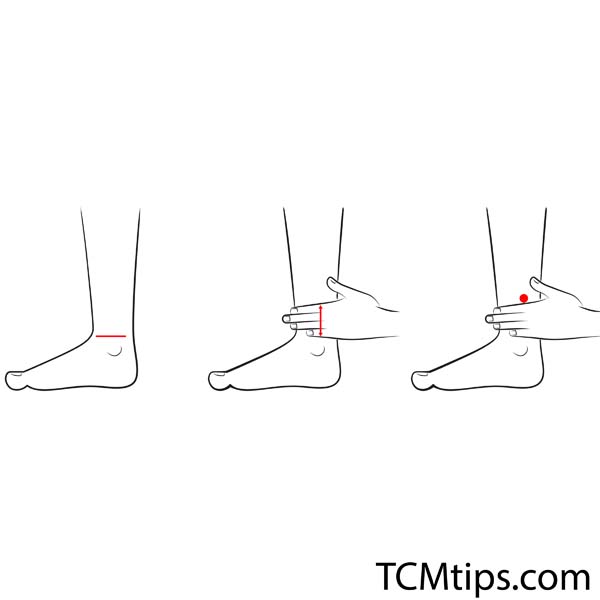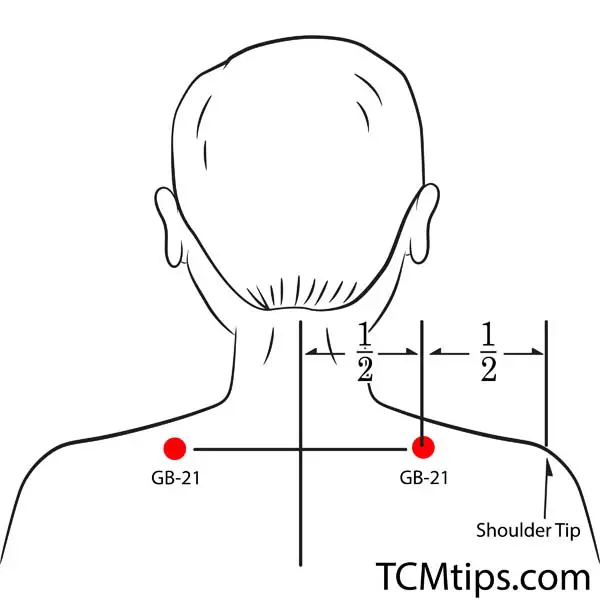What Acupressure Points Induce Labor?
Acupressure points to start labor can be a game-changer for those navigating the complex journey of childbirth. This transformative experience, filled with many emotions and sensations, often comes with its own challenges, such as labor pains. These acupressure points offer a viable solution for those who prefer a natural alternative to medical induction—especially when the due date has elapsed. This article explores how acupressure to start labor can contribute to a smoother and more manageable birthing process. We’ve included a quick reference list below outlining the key acupressure points and their locations.
- SP-6: Inside of lower leg, 4 fingers above inner ankle bone
- Liv-3: Between the big toe and second toe, towards the inseam of the foot
- Bl-23: In line with the lowest point of the last rib, near the spine
- Bl-31: 0.8 cun to the right of the first spinal protrusion at the base of the spine
- Bl-33: Second sacral foramen beneath the BL-31 point
- Bl-34: Third sacral foramen beneath the BL-33 point
- GB-21: Halfway between spine and shoulders, above shoulder blades
- Bl-32: First sacral foramen beneath the BL-31 point
- Bl-67: Lateral portion of the foot near the pinky toe
How To Do Acupressure To Induce Labor?

If you plan to use acupressure points to start labor, you will first need to know how acupressure is performed. This practice involves identifying specific pressure points for inducing labor, which can affect the duration and pain levels during labor. Luckily, I have already identified and listed the points that I have found to be most helpful.
Once you identify each point and its purpose, you can apply firm but gentle pressure to the point for a few seconds at a time. Some people include a gentle rubbing motion for increased relaxation. You will want to use something dull, accurate, and firm, which is why most people use their fingers. Be sure not to press so hard as to cause any pain, and it is worth noting that some of these points are best activated by a partner as they may be difficult to reach for a pregnant woman who is at full term.
Acupressure Points To Induce Labor And Delivery
Acupoint: SP-6 (Other Names: Spleen-6/San Yin Jiao/Three Yin Intersection)

If you’re exploring ankle pressure points to induce labor, SP-6 is a crucial point you shouldn’t overlook. Located on the inside of your lower leg, four fingers above your inner ankle bone, this point is easy to find. To stimulate it, apply moderate pressure using your thumb or knuckle for about one minute.
Ms. Mai Sogawa, a TCM therapist from Japan, further elaborates on the significance of SP-6. This point intersects three essential meridians—spleen, kidney, and liver—all of which pass close to the uterus. This makes SP-6 particularly effective for improving blood circulation around the uterus and promoting uterine contractions, thereby making it a valuable point for stimulating labor.
Personal Tips from Ms. Mai Sogawa
To maximize the effectiveness of SP-6, Ms. Sogawa suggests applying acupressure towards the bone on the inner side of the shin. This aligns with the point’s location at the edge of the bone, enhancing its impact.
The Most Effective Acupressure Point for Labor
According to Ms. Sogawa, SP-6 stands out as one of the most effective acupressure points to start labor, particularly for its uterine contraction-inducing properties.
Acupoint: GB-21 (Other Names: Gallbladder-21/Jian Jing/Shoulder Well)

This point is unique as it joins the gallbladder, triple energizer, and stomach channels. In doing so, it can affect multiple parts of the body from a single location. This is known as one of the best acupressure points for neck pain. Still, its influence also commonly results in the induction of labor, and its ability to induce labor is so well known that trained acupuncture professionals are instructed not to activate this point on pregnant women who are not ready to go into labor.
The GB-21 point is located on the back of the muscle above the shoulder blades. It exists halfway between the spine and shoulders and can be activated on each side with gentle pressure. It is usually easiest to apply pressure to this point using your thumbs, and it is most accessible through the help of a partner.
Acupoint: Bl-32 (Other Names: Urinary Bladder-32/Ci Liao/Second Crevice)

The BL-32 point aligns with the other three bladder channel points noted earlier. It is often categorized as an effective acupressure point for constipation. However, it is better known for inducing labor than calming pain associated with active labor. Though it is not yet completely understood how this point induces labor, many midwives, acupressure practitioners, and mothers stand by the usefulness of this point.
This point falls right beneath the BL-31 point, placing it at the first sacral foramen beneath the BL-31 point. This should be easily identifiable in relation to the prior bladder channel points, and it should only be activated with the permission of a medical professional.
Acupressure For Natural Pain Relief In Labour
Acupoint: Liv-3 (Other Names: Liver-3/Tai Chong/Supreme Rush)

This point has a similar effect to the SP-6. It improves blood flow to benefit the pelvic muscles that generate pain with every contraction. This is also one of a few acupressure points to induce labor on feet, making it useful in various ways, including reflexology for hip pain.
Locating the Liv-3 point is simple if you know where to look. Start by tracing the indent between the big toe and the second toe. As you move up and towards the inseam of the foot and ankle, you should notice a slight dent where the bones meet. This is precisely where you want to apply pressure for approximately 3 seconds before releasing for 3 seconds. After a few activations, some relief should be felt from the labor pains.
Acupoint: Bl-23 (Other Names: Urinary Bladder-23/Shen Shu/Kidney Transporter)

Giving birth strains many different parts of the body, including the back and the many nerves in that area. The bladder channel provides direct access to this area for pain relief and is an ideal acupressure point for kidney health. This point, in particular, helps with gynecological complications, which include labor pains.
To activate the BL-23 point, look at the patient’s back and the lowest point of their last rib. This acupoint should align with that rib or at the same level as your belly button. So, trace back to the spine and apple pressure about 1.5 cun to the right of the spinal protrusion in that location. Since this area is so close to the spine and the organs included in giving birth, be sure to apply firm yet gentle pressure and stop if it becomes painful.

Acupoint: Bl-31 (Other Names: Urinary Bladder-31/Shang Liao/Upper Crevice)

This point is deeply connected to sacral pain, and though it is normally used for sciatica, it can also be beneficial as a solution to pregnancy pains. It is thought that the point aids in calming nerves found in this lower area of the pelvis and spine and is known to be one of the best pressure points in the buttocks for pain control.
This point is easy to locate quickly as it is about 0.8 cun to the right of the first spinal protrusion that can be felt starting at the base of the spine.
Acupoint: Bl-33 (Other Names: Urinary Bladder-33/Zhong Liao/Middle Crevice)

The bladder 33 point is closely related to the bladder-31 point and has similar effects when stimulated. This point is connected to the sacral and lumbar region, resulting in its ability to relieve the pain felt in both areas. This point is also known as a great acupressure point for bladder health, which is extremely important during and after pregnancy.
If you have already located the BL-31 point, this one should also be easy to identify. BL-31 exists in a small indent known as a sacral foramen. It is in the first sacral foramen. You should feel other consecutive indents as you slide your finger down from this position. The BL-33 point will be located in the second sacral foramen beneath the BL-31 point.
Acupoint: Bl-34 (Other Names: Urinary Bladder-34/Xia Liao/Lower Crevice)

The pattern of bladder channel points repeats itself with this third sacral region point. They may all offer the same relief from uterine contractions but are still beneficial pressure points in the buttocks. When combined, these points help improve circulation and energy flow throughout the pelvic region, where most birthing pains are present.
To find the BL-34 point, simply slide your finger down one more sacral foramen, as explained prior, and apply gentle pressure.
Acupressure To Speed Up Labor And Delivery
Acupoint: Bl-67 (Other Names: Urinary Bladder-67/Zhi Yin/Reaching Yin)

Labor and delivery are strenuous processes, and they can feel exhausting when they go on for too long. The bladder channel 67 point is a simple solution to increasing the speed of labor and delivery for a less painful and less complicated birthing process. It is thought that this point is effective in speeding up the delivery process because it helps create balance in the mother’s body, making the baby assume the proper position for delivery.
The BL-67 point is the last point in the bladder channel, placing it on the lateral portion of the foot near the pinky toe. It is next to the edge of the pinky toenail and requires gentle activation.
Both Liv-3 and Bl-67 are notable acupressure points to induce labor in feet, making them particularly useful for those who prefer foot reflexology.
Precautions for Using Acupressure to Start Labor
If you’re considering using acupressure points to start labor, Ms. Mai offers several key precautions to ensure both effectiveness and safety:
- Pressure Application: Use moderate pressure to stimulate the points without causing discomfort.
- Hand Temperature: Ensure your hands are warm before starting, as cold hands can counteract the benefits.
- Body Positioning: If you find it difficult to reach points on the feet due to a large belly, consider having a partner assist you.
It’s important to note that while acupressure can be a helpful tool, one should always consult with a healthcare provider before attempting any new therapies, especially during pregnancy.
When to use Acupressure to Start Labor
Ms Mai also provides valuable advice on when it might be best to avoid using acupressure to start labor:
- Unusual Symptoms: If you experience any discomfort or unusual symptoms, it’s best to refrain from acupressure.
- Before Bedtime: Avoid practicing acupressure right before bedtime to prevent sleep deprivation, especially since childbirth requires physical strength.
- Partner Up for Better Results: Ms. Mai Sogawa advises sharing these acupressure points with your partner in advance. This way, they can assist you during labor, making the process more manageable and effective.
- Daily Practice: Consider starting the acupressure yourself daily as you approach your due date or during the final stages of pregnancy. This proactive approach can prepare your body for the labor process.
Does Acupuncture Really Induce Labor?

Pregnancy and birth are a journey unique to each mother. There are variations and particular scenarios, but professionals in gynecology and acupuncture both support the use of acupuncture to induce labor naturally. Acupuncture is an ancient form of Chinese medicine that has persisted today due to its practical nature. It is based on improving natural processes through unblocking energy and relieving stagnant areas of energy throughout the body. This process is considered highly beneficial for inducing labor because it is a time of high energy flow, and support can improve the body’s ability to perform its natural function. As long as you and your baby are healthy and you have carried them to full term, acupressure points to start labor should be adequate.
The scientific study of using acupuncture to induce labor lacks research and provides conflicting results, but its historical success makes up for this lack of modern information. It is also worth noting that acupuncture and acupressure are two practices that improve energy flow by activation points within the body. Acupressure points to start labor are generally prioritized over acupuncture points as they do not require needles and can be performed in many situations, including when you are rushed to the hospital after your water breaks.
How Long After Acupressure Does Labor Start?

The ability to induce labor through acupressure may seem magical, but it is not an immediate cure-all. The time it takes acupressure to induce labor heavily depends on the pregnant woman involved, the length of their gestation, and a variety of other factors. If you start administering acupressure to induce labor, it is normal for the results to take a little while. So stay alert and try the points again, depending on their daily recommended activations. As with acupuncture for many other conditions, results could happen in minutes to hours or even days.
Once you are in active labor, acupressure points can still be used to speed up your labor. Though acupressure for pregnancy requires far more research, one study found that women who received acupressure for 30 minutes during contractions gave birth in half the time it took women who did not receive acupressure in that study. This suggests that the acupressure process of labor induction may be hard to track, but its results are visible while you are in labor.
Is Using Acupressure To Induce Labor Safe?

As long as you are in the presence of a medical professional, such as a midwife, nurse, or doctor, using acupuncture points to start labor is considered safe. This is because no needles are involved in this form of acupoint activation, so there is minimal risk of harming the mother or child as long as gentle pressure is used at the correct points. It is best to be in the presence of a professional because they will be ready to assist as soon as active labor begins, and they can maximize safety throughout the birthing process.

Try our Anti-Aging Gua Sha Tool designed to bring out your skin’s natural glow.
Best Gua Sha Product- Anti-Aging: The tool is designed to target 11 specific aging signs such as wrinkles and sagging skin. By following the 7-step routine, users can improve skin firmness and reduce fine lines naturally.
- Enhances Skincare Routine: It works effectively with serums and lotions, boosting absorption and efficacy of skincare products.
- Visible Skin Improvement: Users can expect a smoother complexion, reduced puffiness, and a more youthful appearance.
 P. Sze
P. Sze 

















